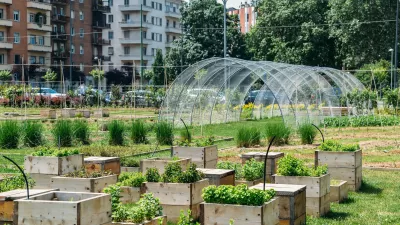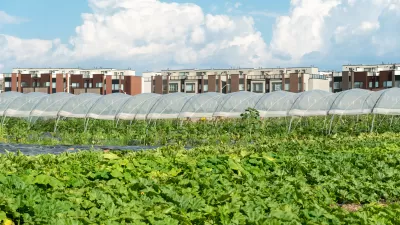Throwing cold water on the latest "techno-optimism" for indoor, urban agriculture.

Joe Cortright writes of his skepticism about urban farming—despite the popularity of "techno-optimistic stories about how a new era of hyper-local food grown in your neighborhood or very nearby." The latest example of which, and the inspiration for Cortright's response, is an article by Adele Peters for Fast Company: "Has This Silicon Valley Startup Finally Nailed the Indoor Farming Model?"
"While the story is replete with VC-pitch based talking points about the efficiency of some aspects of the indoor farming model–purportedly 1 percent as much water use as field crops, 30 miles to the consumer, not 3,000, plus [Plenty] uses LED lights are 64 times more cost-effective than those available a few years ago–one fact is conspicuously missing from the narrative," writes Cortright. That is: "How much will consumers be asked to pay for indoor-grown kale and basil?"
Cortright's concern is with the "dubious" economics of urban agriculture. According to his calculations, urban farming has to 100 times more efficient than conventional farming to cover the cost of land. Instead of a game changer of sustainability, Cortright predicts indoor farming will remain a niche technology for specialized, premium products.
FULL STORY: Dirt cheap.

Alabama: Trump Terminates Settlements for Black Communities Harmed By Raw Sewage
Trump deemed the landmark civil rights agreement “illegal DEI and environmental justice policy.”

Planetizen Federal Action Tracker
A weekly monitor of how Trump’s orders and actions are impacting planners and planning in America.

The 120 Year Old Tiny Home Villages That Sheltered San Francisco’s Earthquake Refugees
More than a century ago, San Francisco mobilized to house thousands of residents displaced by the 1906 earthquake. Could their strategy offer a model for the present?

In Both Crashes and Crime, Public Transportation is Far Safer than Driving
Contrary to popular assumptions, public transportation has far lower crash and crime rates than automobile travel. For safer communities, improve and encourage transit travel.

Report: Zoning Reforms Should Complement Nashville’s Ambitious Transit Plan
Without reform, restrictive zoning codes will limit the impact of the city’s planned transit expansion and could exclude some of the residents who depend on transit the most.

Judge Orders Release of Frozen IRA, IIJA Funding
The decision is a victory for environmental groups who charged that freezing funds for critical infrastructure and disaster response programs caused “real and irreparable harm” to communities.
Urban Design for Planners 1: Software Tools
This six-course series explores essential urban design concepts using open source software and equips planners with the tools they need to participate fully in the urban design process.
Planning for Universal Design
Learn the tools for implementing Universal Design in planning regulations.
Clanton & Associates, Inc.
Jessamine County Fiscal Court
Institute for Housing and Urban Development Studies (IHS)
City of Grandview
Harvard GSD Executive Education
Toledo-Lucas County Plan Commissions
Salt Lake City
NYU Wagner Graduate School of Public Service





























